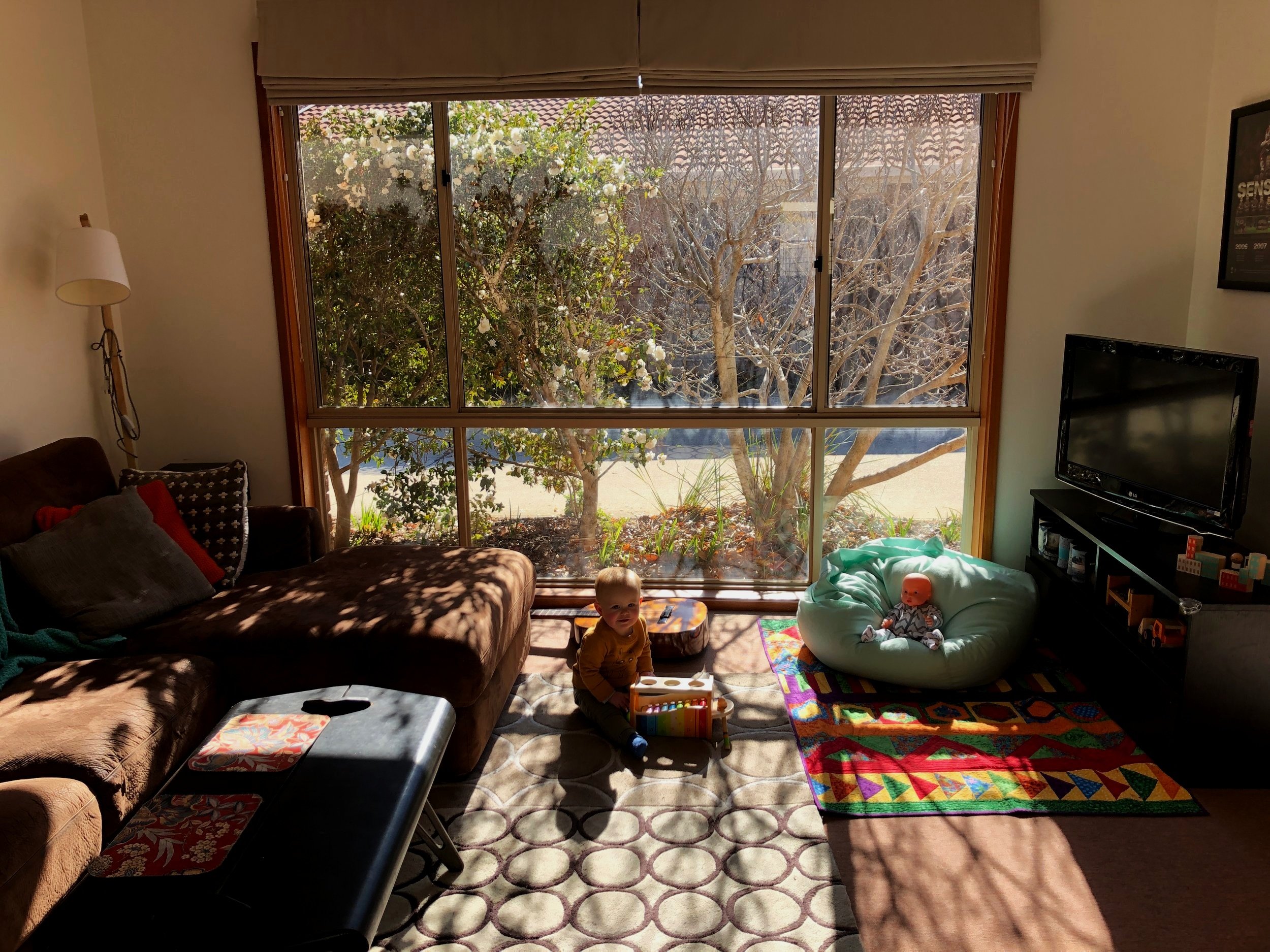
Can you dramatically improve your home’s thermal comfort for less than $20k?
Sarah and Johno’s Retrofit
(Palmerston | Ngunnawal Country)
Our first house, where we lived until our move back to the family farm, was a traditional 90s, slab on ground, 3 beddie, 116m² brick veneer house, in Canberra. After almost a year of house hunting, we stumbled across a place with amazingly ideal orientation; with no east or west windows and large northern glazing.
There are no east or west facing windows
Deciduous plants shade the north facing windows during summer
We spent around $9,000 on draft sealing, installing pump-in wall insulation and fixing gaps in ceiling insulation, putting in ceiling fans, having snug-fitting roman blinds installed, and replacing the gas hot water system with an electric heat pump. The EER of our all-electric home has increased from 2.9 stars to 5.7 stars. This represents roughly a 60% reduction in heating and cooling energy requirement (and greatly increased comfort in general). We rarely need to switch on our one small RCAC split system over summer, and our winter energy bill is very small. Even in our last year there, as a four-person household and with myself home full time over winter, with a newborn, our biggest bill ever was $636!
This makes the payback period for our retrofit costs less than five years.
We installed ‘Insulbloc’ pump-in insulation in the walls
We replaced our old hot water system with a super-efficient heat pump system.
We used ‘UltraClear’ to gap seal around windows, architraves and skirting.
Installing draft-seals around doorways and blocking off permanent window vents is an immediate win.
I spent time in the ceiling making sure insulation was installed with no gaps.
Jenny from Light House Architecture and Science thermal imaging to find weak points.
Thick, snug fitting curtains that reduce air movement past the window are as effective as another layer of glazing when closed.
We upgraded our fans to vent externally, with backdraft stoppers. You can also retrofit ‘Draft Stoppas’ like this over ceiling vents.
Download the full pamphlet:
When we sold this house in 2024 we created a pamphlet that summarised it’s energy-efficiency and sustainability credentials. It includes some extra detail on things you might consider for your own small-budget retrofit. You can download a copy here.
Should you do the same?
For typical homes, the order of best ‘bang for buck’ is usually:
Draft-proofing. Sealing up drafts is the single most cost effective thing you can do to reduce your heating and cooling bills. The results often correlate linearly with your electricity bills savings, i.e. halving the air leakage rate of your home has been shown to halve your power bill. My favourite resource for how to get started draft-proofing your home is Green It Yourself.
Insulation is usually your next win, especially topping up roof insulation to R5, or pumping in wall insulation if you can. (Under floor insulation is also helpful but the return on investment usually comes later down the list).
Window dressings and window shading. Installing thick internal window dressings that reduce air movement past your window will help with heat-loss in winter. Installing external shading devices that stop sunstrike on your windows in summer will help with unwanted heat-gain in summer.
Don’t forget appliances and lighting. If your appliances are older you might want to switch your hot water system or heating system to an electric heat pump system.
What about upgrading windows? Yes, windows are a huge weakness in your home, but they are also expensive to replace. You can see from the case study of our own home above, that we achieved good results without upgrading the windows. Please note that this doesn’t justify low quality windows in a new build - investing in windows is still a critical item when undertaking a new build or significant renovation.
What if my house isn’t typical?
If you’re not confident about the right steps to take, it really is worthwhile to seek an assessment by an energy-efficiency consultant. After all, missing one item can have a detrimental impact on the performance of your home. Similarly, if you have condensation concerns, a holistic expert opinion is recommended.
Please download our Information Package to learn more about where to seek this advice and how I can help you facilitate connection and assessment by professionals if you a regionally based.
A note on size
If we’re talking about sustainability, we must relate this to a conversation about house size. Along with the USA, Australians build the biggest new houses in the world at 235.8m². (Full report here). The Global Footprint Network calculates that we use 74% more resources than the planet can make. The Global Status Report 2017 stated that building and construction are responsible for 39% of energy-related C02 emissions.
I was so proud of how hard our 117m² (+36m² garage) worked for us. Our third bedroom was amusingly one of the hardest working rooms in Canberra; at 2.8 x 3.2 meters it functioned as a home office, temporary nursery, and guest bedroom all in one.
It's so easy to wish you had more space, but I loved having a smaller mortgage, smaller bills, and a smaller footprint; it allowed us more financial, mental, and ethical space to enjoy life.








